Turning points in modern South African History since 1948&
In 1948 South Africa held a general election which was to be decided by the white population of the country. A manifesto outlined how Apartheid would be implemented in practice which was enforced by the National Party (NP) when they won the election. The focus of this lesson will be on some of the key turning points in South African history, including the coming of apartheid in 1948 and non-violent resistance to apartheid in the 1950s.
The Universal Declaration of Human Rights after World War II
The Universal Declaration of Human Rights (UDHR), also known as the Magna Carta, was adopted by the United Nations General Assembly on 10 December 1948. Due to the experience and effects of the Second World War, the international community vowed to prevent the atrocities and conflicts that occurred during the Second World War to take place again. After approximately six million Jews, Gypsies homosexuals and people with various disabilities were exterminated, the idea of Human rights grew and there was a need to protect every inpidual from these heinous crimes.The United Nations was born from various governments with the principle aim to bolster international peacE and prevent crime and conflict. World leaders then decided to codify these rights that are attributed to each inpidual within a single document, hence the Universal Declaration of Human Rights. This document aimed to be the fundamental document of all countries with regard to human rights and strove to secure these rights to all inpiduals.
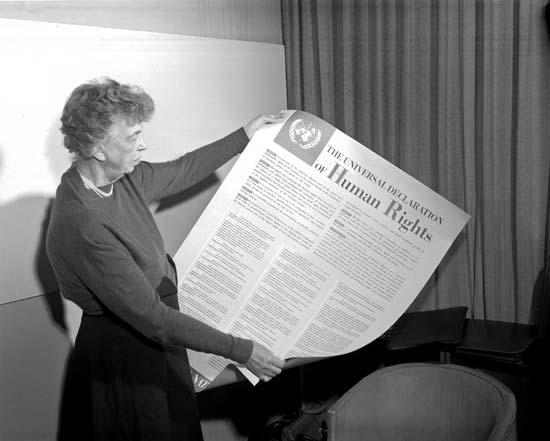 Eleanor Roosevelt holding a poster of the Universal Declaration of Human Rights. Image source
Eleanor Roosevelt holding a poster of the Universal Declaration of Human Rights. Image source
The Universal Declaration of Human Rights captured the international community’s need to guarantee that no one would ever be unjustly denied life, freedom, food, shelter and nationality; as occurred during World War II. The Commission of Human Rights was established within the United Nations which laid out the basic fundamental rights and freedoms as proclaimed in the Charter. One of the most significant aspects of the UDHR is legitimization of the notion that how a government treats its citizens is, especially after World War II, an international concern, and not just a domestic issue. The importance of the UDHR can be seen in the fact that some of the principles have been adopted into national constitutions.
In its preamble and in Article 1, the Declaration unequivocally proclaims the inherent rights of all human beings: “Disregard and contempt for human rights have resulted in barbarous acts which have outraged the conscience of mankind, and the advent of a world in which human beings shall enjoy freedom of speech and belief and freedom from fear and want has been proclaimed as the highest aspiration of the common people...All human beings are born free and equal in dignity and rights.”
The Declaration of Human Rights is the most universal human rights document in existence, delineating the thirty fundamental rights that form the basis for a democratic society.
Definition of racism
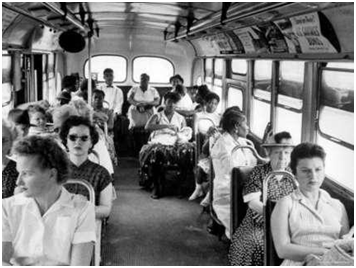
According to the Merriam Webster Dictionary definition, racism can be described as the “poor treatment of or violence against people because of their race”, and it supports the notion that “some races of people are better than others”. Throughout history race has been associated with the belief that it is a primary determinant of human traits, and it has played a significant factor in the way that power relations occur. Below follows two different discourses regarding the definition and understanding of racism throughout history, as well as South African history.
Human evolution and our common ancestry
Human Evolution describes the extensive process of change where people originated from apelike creatures. Aspects of Human Evolution has been proved by scientific evidence and one of the the main findings that forms the fundamental basis of Evolution is that physical and behavioural traits, which are shared by all humans, originated from these apelike ancestors and have evolved for approximately six million years.
Apartheid and the myth of ‘race’
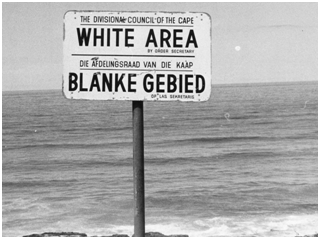 Africa's Apartheid struggle and were implemented under the Separate Amenities Act. Image source
Africa's Apartheid struggle and were implemented under the Separate Amenities Act. Image source
The construct can be seen as a highly notorious term, despite it having no physical basis. This term was, however, heavily used in South Africa’s pre- democracy phase, Apartheid. During this period between 1948 and 1994, race was used as a measure to categorize and distinguish people from each other, and determined their position within society. To be more specific, this system categorized people on the basis of their skin colour. All aspects of society were pided to facilitate the complete pision of all race groups. Certain activities and privileges were only reserved for certain people of a specific race. In short, Apartheid was the system during which Africans were legally, socially, politically and economically disenfranchised while the National Party governed South Africa. It is a fact that in any society, race is never an objective, biological characteristic; race is a socially created construct.
Apartheid, literally meaning (if translated into Afrikaans) “to be in a state of being apart”, was further facilitated by institutionalized Apartheid laws, which further dictated the everyday lives of South Africans. These laws determined where blacks would stay, work, and even who they would marry. During modern times, the indicators of the pision of people are class, status, education, etc. During Apartheid, race was the only aspect that pided society.
1948 National Party and Apartheid
Racial segregation before Apartheid
Before the official institutionalisation of Apartheid in 1948, some historians saw it as a complex development that started during the 20th century which was linked to the evolution of South African Capitalism. After the Mineral Revolution took place in South Africa, cheap labour became widely used (which was advocated by Cecil John Rhodes), which the dominating notion that Black labour was cheaper to use in mines and on farms. It is also believed that Apartheid was an outcome of earlier racial prejudices and policies imposed by the British and Dutch. Various sources can be attributed to the cause of Apartheid, or rather the idea of racism. These include colonial conquest, land dispossession, economic impoverishment and exclusion from citizenship for black Africans. These factors shaped the way the world saw Africans and influenced the negative manner in which they were perceived.
Uneven and, in some cases limited, capitalist growth was facilitated by the colonial conquests of the British and Dutch during the 17th and 18th centuries. The Dutch East India Company (VOC) was established in 1795 with the aim of being a refreshment station for passing ships. When it was established, it was done so at the expense of indigenous citizens, such as the KhoiKhoi and Xhosa people. The Khoi societies sustained their livelihood through their land and livestock, and when the VOC took over their land, the Khoi were subjected to becoming underclass domestic farm workers. They were further disenfranchised when the VOC imported slaves imported from Angola, Mozambique, Madagascar and South East Asia, which curtailed the Khoi’s chances of earning a decent wage.
Apartheid arose when the National Party, who represented ethnic Afrikaner Nationalism, won the National election on the basis of racism and segregation in 1948. It significantly extended the reach of the racist state and led to a systematic and fundamental deterioration of the position of black people in South Africa until 1994.
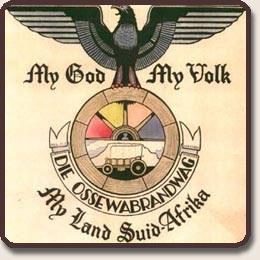 The 'Ossewabrandwag', a group who pleged not to rest before the Afrikaner Nation was reclaimed. This was one of the ways that Afrikaner Nationalism was expressed. Image source
The 'Ossewabrandwag', a group who pleged not to rest before the Afrikaner Nation was reclaimed. This was one of the ways that Afrikaner Nationalism was expressed. Image source
The victory of the NP in 1948 can be attributed to the rise in Afrikaner Nationalism during the 1920’s and 1930’s. Afrikaners constituted a majority in terms of quantity of the white electorate, but they were pided by class, regional and educational fault lines. When the Afrikaner Broederbond, a secret Afrikaner society, was established in 1918, Afrikaner nationalism grew from a Calvinist perspective which was united by a common language. The Dutch Reformed Church provided a foundation for the theological justification of Apartheid. In terms of capital, the Afrikaners grew and expanded their financial support through the insurance company Sanlam, the Volksklas Bank and Spoorbond. The rise of the use of cheap labour was induced by the emergence of mines, factories and farms. White-owned businesses accumulated big profits by supporting a government that denied blacks the vote and paid artificially low wages. Many white factory workers and World War II veterans voted for apartheid in 1948 to protect their economic advantages and to oppose black urbanization and social welfare. Furthermore, many white families benefited from the work of black domestic servants who provided childcare, cooking, and house care. D.F. Malan and Hendrik Verwoerd can be considered as the architects of Apartheid.
Main apartheid laws in broad outline
The period of the 1950’s can be described as “Petty Apartheid” where Nationalists imposed the laws that created a racially segregated and unequal social order. One of these laws was the 1953 Reservation of Separate Amenities Act that imposed segregation on all public facilities; including post offices, beaches, stadiums, parks, toilets, and cemeteries, and buses and trains as well. In other words, the Act was to provide for the reservation of public premises and vehicles or portions thereof for the exclusive use of persons of a particular race or class, for the interpretation of laws which provide for such reservation, and for matters incidental thereto.
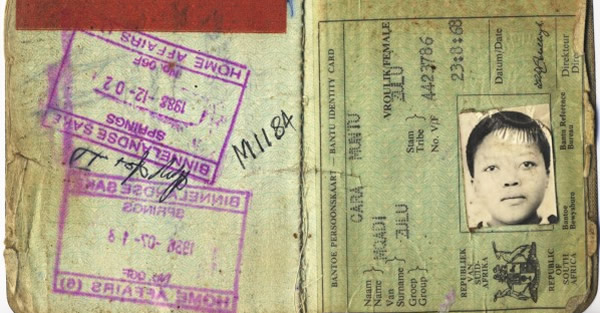 This is an example of a Pass book that all non- whites were required to have at all times. It indicates the race of an individual. Image source
This is an example of a Pass book that all non- whites were required to have at all times. It indicates the race of an individual. Image source
The Pass Laws Act of 1952 was implemented to ensure that a supply of cheap African labour, and increasingly they were made more restrictive. This law required all black South Africans over the age of 16 to carry a pass book, known as a dompas, everywhere and at all times. It was a criminal offense for Africans to be without a pass and made movement and residence dependent upon a pass. Within the pages of an inpidual's dompas was their fingerprints, photograph, personal details of employment, permission from the government to be in a particular part of the country, qualifications to work or seek work in the area, and an employer's reports on worker performance and behavior. If a worker displeased their employer and they in turn declined to endorse the book for the pertinent time period, the worker's right to stay in the area was jeopardized.
Two laws that were implemented during this time had arguably the biggest impact on the country.
The Population Registration Act, which commenced 7 July, classified all South Africans as members of the White, African, Coloured, or Indian racial groups, and because racial identities were (and are) historically and socially constructed, the government created Racial Classification Boards to officially determine a person’s "race." A person’s race was reflected in their identification numbers.
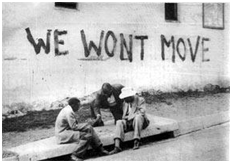 SEQ Figure \* ARABIC 1A community responding to the forced removals under the Group Areas Act by painting the famous slogan "We Won't Move". Image source
SEQ Figure \* ARABIC 1A community responding to the forced removals under the Group Areas Act by painting the famous slogan "We Won't Move". Image source
The Group Areas Act imposed strict residential racial segregation. Apartheid social engineering irreparably damaged countless families, communities, and livelihoods, as the government forcibly removed blacks to African, Coloured, or Indian "townships" (also known as "locations") on the outskirts of cities and towns. In the process of enforcing this plan, government bulldozers destroyed vibrant, racially mixed neighbourhoods, such as Sophiatown in Johannesburg and District Six in Cape Town. In practice this meant that all white, black, coloured and Asian people in South Africa would have to live in group areas allocated to members of their groups. Their ownership of property and business rights would be confined to those areas. This also meant that many people had to move out of their homes where they had lived for years and go and live in unfamiliar places which they knew little or nothing about because they had occupied a Group Area designated for another race. Township residents tried to rebuild their lives despite inadequate housing, material poverty, and, for Africans, the constant danger of arrest for not carrying a pass book.
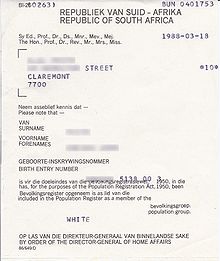 A racial classification Certificate issued under the Population Registration Act. Image source
A racial classification Certificate issued under the Population Registration Act. Image source
The Immorality Act caused couples of differing racial backgrounds to be tracked down by the police who were suspected of being in a relationship. Homes were invaded, and mixed couples caught in bed were arrested. Underwear was used as forensic evidence in court. Most couples found guilty were sent to jail. Blacks were often given harsher sentences than whites.
The impact of Apartheid on education was so profound it can still be seen today. Verwoerd’s 1953 Bantu Education Act established an inferior education system for Africans based upon a curriculum intended to produce manual labourers and obedient subjects. Similar discriminatory education laws were also imposed on Coloureds, who had lost the right to vote in 1956, and Indians. The government denied funding to mission schools that rejected Bantu Education, leading to the closure of many of the best schools for Africans. In the higher education sector, the Extension of University Education Act of 1959 prevented black students from attending "white" universities (except with government permission) and created separate and unequal institutions for Africans, Coloureds, and Indians respectively. The apartheid government also undermined intellectual and cultural life through intense censorship of books, movies, and radio and television programs. Censorship reached absurd proportions, exemplified by the banning of the children’s book Black Beauty and the tardy introduction of television in 1976. After that date, government-controlled broadcast media regularly disseminated apartheid propaganda. Educational ties with the rest of the world gradually diminished as countries applied a cultural boycott on South Africa.
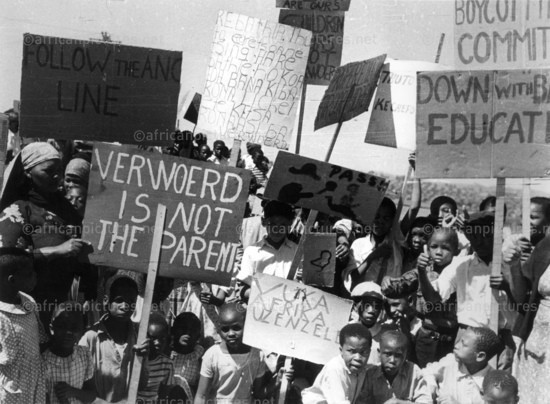 A protest n response to the Bantu Education Act that was adopted by Verwoerd, which stipulated that all learners should be taught in Afrikaans. Image source
A protest n response to the Bantu Education Act that was adopted by Verwoerd, which stipulated that all learners should be taught in Afrikaans. Image source
In the 1960s the pursuit of white domination led to a new policy of "Grand Apartheid." As a massive social engineering project, grand apartheid created ethnically defined "Bantustans" (or "Homelands") out of the "Tribal Reserves" carved out by the 1913 Land Act. Between 1960 and 1985, approximately 3.5 million Africans were forcibly removed to alleged "homelands." These rural dumping grounds functioned as reservoirs of cheap black labour for white employers, but the apartheid regime also envisioned them as "independent" territories that would ensure the denial of South African citizenship to millions of Africans. Some of these territories, such as Bophuthatswana, comprised dozens of isolated pieces of territory with no common frontier. Situated in the most unproductive regions of the country, Bantustans were inhabited largely by poverty-stricken women and children since men migrated annually to work in South African cities and towns, and farms as well. Generally, government-approved "tribal" leaders ruled over the Bantustans in violent and corrupt fashion with the full support of the South African government, which was responsible for their entire budgets and provided military assistance.
Case study: Group Areas Act: Sophiatown forced removal
Sophiatown was established in 1904. Before 1913 black South Africans had freehold rights, and they bought properties in the suburb. By the 1920s whites had moved out, leaving behind a vibrant community of blacks, coloureds, Indians and Chinese.
One of the most controversial actions occurred in the mid-1950s when blacks living in Sophiatown, Johannesburg, were compelled to move along with many others to a vast new black township southwest of Johannesburg, called Soweto. In 1955, army trucks and armed police removed 60,000 people from Sophiatown to areas that were designated for Africans such as Meadowlands, Lenasia, Western Coloured Township (now Westbury) and Noordgesig.
Sophiatown was rezoned for whites only and renamed Triomf (Triumph). The removals sparked the creation of a song called “Meadowlands”, in reference to the Meadowlands township to which many Sophiatown residents were forced relocate. Another removal that caused particular outrage occurred in the second half of the 1960s, when 65 000 Coloured people from District Six, a vibrant inner city ward of Cape Town, were forced to leave.
One white observer remarked:
“It was a fantastic sight. In the yard [opposite the local bus station] military lorries were drawn up. Already they were piled high with the pathetic possessions which had come from the row of rooms in the background. A rusty kitchen stove; a few blackened pots and pans; a wicker chair; mattresses belching out their coir stuffing; bundles of heaven-knows-what; and people, all soaked to the skin by the drenching rain”.
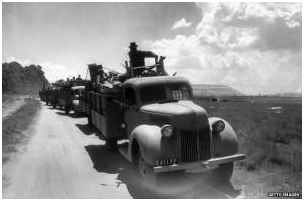 The Apartheid Government transporting all non- whites from Sophiatown to other surrounding townships.
The Apartheid Government transporting all non- whites from Sophiatown to other surrounding townships.
When the removals scheme was promulgated, Sophiatown residents united to protest the forced removals, creating famous the slogan "Onsdaknie, onspholahier" (We won't move). Another source states that "We got a notice that we were going to be moved on 12 February 1955, but we were taken by surprise by thousands of policemen and soldiers, who were heavily armed, "We were still preparing ourselves to protest the removals, and we had no choice because no one was ready for them - and besides, they were armed". Some people did not qualify for resettlement, so they had to find their own accommodation. Many people moved to Orlando East and other parts of Soweto.
The Forced Removals Act disrupted the existing family dynamic due to racial classifications and separation of group areas.
Dr Alfred Xuma, who lived in Toby Street, was one of the last residents to leave Sophiatown in 1959. Today, his house is one of only two houses that managed to escape the destruction of Sophiatown by the apartheid government.
The removals continued for over eight years. Blue-collar Afrikaners were moved in, and still largely occupy the small houses that replaced the lively but desperately poor three-bedroomed homes and backyard shacks of Sophiatown.
Case study: Bantustans: Forced removal: People of Mogopa to Bophuthatswana
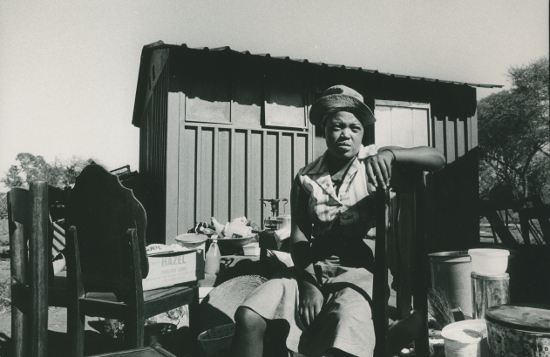 A woman sitting outside her shack with all her belongings after being forcefully removed from Mogopa. Image source
A woman sitting outside her shack with all her belongings after being forcefully removed from Mogopa. Image source
For over 70 years, these people had lived on good land which their forefathers purchased before the 1913 Land Act made this impossible. Then their land was designated a “black spot” in a white area and they were ordered to move to Pachsdraai, in Bophuthatswana. They refused to move. The government, confronted by organized and strong resistance, mounted a counterattack. It imposed a new corrupt chief whom the community refused to recognize. Bulldozers razed the school, the church, and some houses. It withdrew services, no pensions were paid out, no annual labour contracts were issued and the bus service was suspended. Still the people of Mogopa stood fast.
Then a removal squad arrived, complete with tractors, trucks and buses, and camped on their land. Challenged in court for trespass, the government backed down temporarily. But soon the people of Mogopa received an order to leave by November 29, 1983. Hundreds of supporters, black and white church people, students, political groups and the press arrived to wait with the Mogopa people for the government trucks. They did not come. The supporters returned home.
The Mogopa people began to rebuild their battered community. They raised money to buy a new water pump. The men rebuilt the school. The women repaired the roads.
But in the early hours of the morning of February 14, 1984, heavily armed police arrived in Mogopa and declared it an “operational zone” a term usually reserved for the war zones of Namibia. No outsiders were allowed in. Lawyers, priests, diplomats and the press were all turned away at the entrance. The police, working with dogs, forcibly loaded people and belongings onto buses and trucks and took them to Pachsdraai. They arrived to a barren welcome, with their furniture broken, many belongings lost, their cattle sold at a pittance to white farmers, who were the only civilians allowed into the area. Pachsdraai offered little. It was far from towns and job opportunities. The depleted soil was unsuitable for the non-irrigated farming that was the basis of their subsistence agriculture, and the hated imposed headman was given complete control of the allocation of all resources.
The Mogopa people refused to stay, and moved to another area of Bophuthatswana, Bethanie, which is under the jurisdiction of their paramount chief. But their lives are still painfully difficult; the strong community now lives, pided into three groups, without water, without permission to hold meetings, without grazing grounds, without plots to farm, a witness to the real meaning of the bantustan system.
1950s: Repression and non-violent resistance to apartheid
SACP banned
 A protest in support of the South African Communist Party after it had been banned. Image source
A protest in support of the South African Communist Party after it had been banned. Image source
Initially known as the Communist Party of South Africa (CPSA) which was founded in July 1921, its name was changed to the South African Communist Party (SACP) during the 1950’s. The Party was founded on the foundation of various leftist movements, including the International Socialist League (ISL), the Social Democratic Federation, the Durban Marxist Club, the Cape Communist Party, and the Jewish Socialist Society, and affiliated itself with the Communist International (Comintern) which was headquartered in Moscow. By the mid-1940s, CPSA membership was increasing, and the party had gained influence after a few CPSA members (all white) won political office. After the 1948 NP election victory, however, the government quickly restricted black political activity and in 1950 banned the CPSA. The party went underground temporarily but also strengthened its ties to local nationalist organizations, such as the ANC. During the years it was banned, while the ANC continued to operate legally, the CPSA viewed the ANC as the primary expression of black aspirations for a multiracial socialist state under eventual communist leadership. The SACP and the ANC in the 1950s held similar views about policy and tactics as embodied in the ANC's Freedom Charter; in addition, they both advocated the use of guerrilla warfare against the apartheid regime in order to bring about the dual-phase revolution of political liberation followed by economic transformation.
In 1950, the Apartheid Government introduced a bill called the Unlawful Organisation Bill, but later its name was changed to the Suppression of Communism Bill to focus on the undermining and limiting of communism within South Africa due to the government’s concern of a large number of communists infiltrating non- White political organisations.
When the SACP was unbanned in February 1990, its strength was difficult to estimate because many party members had been underground for years. In July 1990, a party spokesman publicized the names of twenty-two SACP members who were prominent in national politics but said that the names of others would remain secret. In 1991 SACP leaders estimated that the party had 10,000 dues-paying members, but refused to publish the party's membership rolls.
ANC programme of action
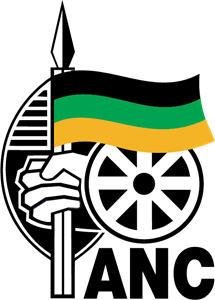 The logo of the African National Congress (ANC). Image source
The logo of the African National Congress (ANC). Image source
A Programme of Action was introduced on 17 December 1949 at the December conference which could be considered as a major turning point in the existence of the party. After the victory of the National Party, which was representative of an Apartheid government, the ANC, who stood for the deals of national freedom, wanted to introduce a policy that would counter the NP’s decision. Through this Programme of Action, the ANC was transformed from a party that was run by Middle Class liberals, to a militant liberation movement. The Programme of Action called on the ANC to partake in mass action, including civil disobedience, strikes, boycotts, and other forms of non- violent resistance.
The ANC Programme of Action was based on the principle of national freedom, which is meant by the freedom from white domination and the attainment of political independence. This would also include the rejection of the notion of segregation, apartheid, trusteeship, and white leadership which are motivated by the idea of white domination over blacks. Another basis for the Programme of Action is the Africans’ desire to claim the right of self determination.
Brief biography: Albert Luthuli, his role in the ANC, and resistance to apartheid
Albert John Luthuli (1898- 1967), was a South African statesman and the first African to win the Nobel Prize for peace. He was born in Solusi mission station, Rhodesia, where his father served American missionaries as an interpreter. On completing a teacher’s course from a Methodist Institution at Edendale around 1917, Luthuli took up a job as principal in an intermediate school in Natal. In 1920, he attended a higher teacher’s training course at Adams College with a scholarship provided by the government and joined the training college staff afterward. Albert Luthuli was elected as the secretary of the African Teacher’s Association in 1928 and subsequently as its president in 1933. It was while he was teaching at Adams that the Groutville community requested him to become its chief. Sugarcane production, which was the reservation's main source of income, had run into difficulties. Luthuli accepted the invitation and saved the community's economy from collapse.
Luthuli regarded the traditional evaluation of the person as transcending all barriers of race because the infinite consciousness has no colour, and that black and white people are bound together by the common humanity they have. He believed that Christian values can unite black and white in a democratic coalition. Apartheid's preoccupation with colour and the particular experience of the Afrikaner outraged him because it gave a meaning to Christian values which used race to fix the person's position in society and set a ceiling beyond which the African could not develop his/her full potential as a human being.
For holding these views Luthuli was later to be deposed, banned, and brought to trial for treason. The law under which he was charged (1956) was the Suppression of Communism Act. South African law recognizes two forms of communism: the Marxist-Leninist, and the statutory. Whoever opposes apartheid with determination or advocates race equality seriously was a statutory Communist.
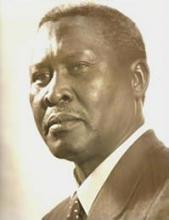 Chief Albert Luthuli Image source
Chief Albert Luthuli Image source
Luthuli had involved himself directly in his people's political struggle and, in 1946, had been elected to the Natives Representative Council, a body set up by James Munnik Hertzog to advise the government on African affairs. Luthuli became president of the Natal section of the African National Congress (ANC) in 1951. In this capacity he led the 1951-1952 campaign for the defiance of six discriminatory laws.
In 1936, the government imposed total restriction on the non-white community, circumscribing every aspect of their lives. Luthuli’s concern for all black people made him join ANC (American National Congress) in 1944. The Africans were denied the right to vote, and in 1948 the government adopted the policy of racial segregation, known as ‘Apartheid’; the Pass Laws were tightened in the 1950's. The objective of the ANC was to secure human rights for the black community, bringing them the rights to justice and equality.
He was elected to the committee of the Natal Provincial pision in 1945 and soon after, he became the president of the pision in 1951. The following year, he came in contact with other ANC leaders and decided to join them in a struggle for justice and equality for all South African people. He organized non-violent campaigns to raise voice against discriminatory laws and racial segregation. He was charged with treason and was asked to pull out with the ANC or leave his office as tribal chief. Luthuli refused to do either and subsequently, he was fired from his chieftainship. In the same year, he was elected president-general of ANC.
For around fifteen years before his death, Luthuli suffered from high blood pressure and he suffered a slight stroke. Over time his sight and hearing also became impaired. In July of 1967, he was fatally injured when a freight train struck him at the age of sixty nine.
The Defiance Campaign (including the influence of Mahatma Gandhi)
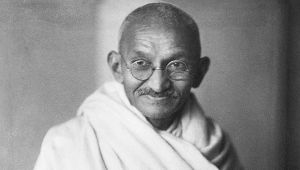 Mahatma Gandhi Image source
Mahatma Gandhi Image source
The ‘Defiance of Unjust Laws Campaign’, as it was formally known, was launched on 26 June 1952 by the ANC and South African Indian Congress (SAIC) in the tradition of Mahatma Gandhi. A tremendous number of people demonstrated against the existing Apartheid Laws by disobeying them to combat Apartheid. The Defiance campaign embraced Gandhi’s notion of Satyagraha, the term he coined in 1907 when he led a batch of volunteers to defy anti-Asian legislation in the Transvaal. Satyagraha entails a firm but non-violent struggle for a good cause. This non-racial initiative raised the controversial issue of the different ‘locations’ of the perse communities it aimed at mobilising, in contrast to the more homogeneous nature of the earlier campaigns, which comprised of Indians only. More than 8000 people of various race groups were arrested for defying the laws of Apartheid by using bathrooms that are not reserved for them, by riding in busses not reserved for them and by committing other offences that were against the law. A major tactic employed by the resistors was choosing to be imprisoned, rather than paying a fine, after arrests which allowed demonstrators to burden the government economically, while giving them a chance to voice their opinions on apartheid when they were tried in court.
In response to the campaign being spread to small rural areas, the South African Security Police, a branch of the government, implemented in August 1952 the biggest police raids on both the offices of the liberation campaign and the homes of liberation leaders. Many of these raids were carried out without legitimate search warrants and if the offices or homes were locked, the police would simply break in. This was a major effort by the South African government to repress the movement, intimidate the people, and find evidence for a trial that would remove the leadership of the campaign. The courts also got involved in the repression by levying the maximum sentence in each case of a resistor. Police brutality also escalated as spectators at trials of protesters were often roughed up by police officers. In prisons, especially, the resistors were targeted by officers for punishment and beatings.
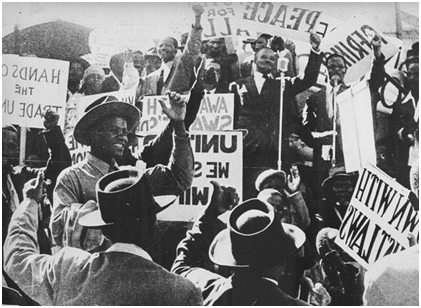
An increasing number of people joined the movement despite the government trying to curtail it. The government aimed all attacks at the leaders of the movement in an attempt to combat the growing popularity of the movement. Nelson Mandela, who was the president of the ANC Youth League at that time, was one of the Defiance Campaign leaders, and was charged with leading the Campaign with the goal of effecting change in both the industrial and social structure of the country using “constitutional and illegal tactics”. This trial provided the foundation for campaigners to spread their message on a national level.
Although this campaign had been non- violent since its formation, a turning point at this trial occurred when riots broke out, which started in New Brighton and moved to Port Elizabeth, continuing to Denver (in Southern Transvaal) on 18 December 1952. An African person was shot by a railway officer in New Brighton after being accused of stealing paint, which was followed by a group of other Africans who witnessed the commotion and threw rocks at the station where the man was shot, which led to the police opening fire on the crowd, killing seven people. The riots of Denver had a different cause than the one in New Brighton. The residents of the Denver African Hostel refused to pay the increased rental fee. This sparked a conflict in which police fired into the hostel, killing three people. Five days later, after three people gave an ANC salute when they finished their drinks in a Municipal African Beer Hall; they were thrown out of the bar. A group accumulated outside the bar and they began throwing rocks at the hall. Police arrived and opened fire on the crowd, killing thirteen Africans and injuring seventy-eight.
At the end of November 1952, the government prohibited all meetings of more than ten Africans throughout the country and then followed by instituting two laws, the Criminal Law Amendment Act (which targeted any person who broke any law in protest or support of a campaign) and the Public Safety Act (which allowed the Cabinet to temporarily suspend all laws whenever they declared a state of emergency and to enact emergency rules for anything necessary). These new laws were meant to directly suppress the campaign. In the middle of April 1953, after the two laws were passed and all of the damage had been done by the riots, Chief Albert John Mvubi Luthuli, the President-General of the ANC, proclaimed that the Defiance Campaign would be called off so that the resistance groups could reorganize, taking into consideration the new climate in South Africa. The Defiance of Unjust Laws campaign had not been successful and the further movement against apartheid would go on for several more decades.
Freedom Charter and Treason Trial
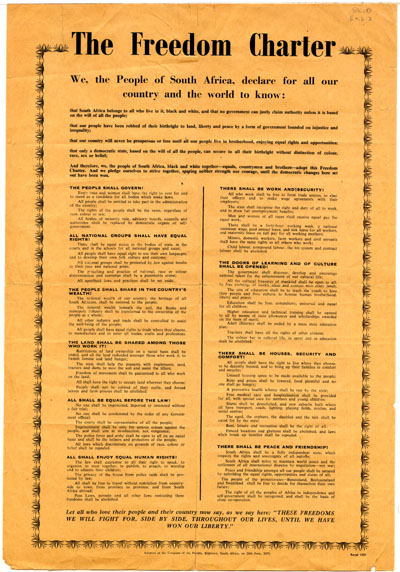 A copy of the South African Freedom Charter. Image source
A copy of the South African Freedom Charter. Image source
The initiative for the adoption of the Freedom Charter came from a multiracial coalition of political organisations, including the ANC, Congress of Democrats, Indian National Congress, and South African Coloured People’s Congress. The Freedom Charter’s basic principles rested on the demands for human and political rights, as well as the image of the society it envisioned to replace the Apartheid System, including ideals of the sharing of wealth, adequate housing, education, and healthcare. In other words, the Freedom Charter consists of the political parties’ emphasis on non-racialism is enshrined in a single seminal document of the liberation movement. It also asserts that South Africa belongs to everyone who owns it - which had a strong socialist basis to it. These statements were sued by the government to ascribe communist influence to the movement, and they arrested 153 leaders of the alliance who were charged with high treason.
The Freedom Charter grew from a campaign to collect the citizens’ ideas for alternative regimes other than Apartheid, which were gathered at meetings. On the June the 26th, 1955 at a Congress where delegates were discussing the Freedom charter, police arrived in force armed with stun guns, and they formed a cordon around the sports field where the discussions were held. Fifteen security policemen then mounted the platform to address the crowd. They claimed that all people present at the congress were committing treason. They then confiscated all documents, posters and film and proceeded taking names and addresses of all the delegates. Everybody was under arrest. A few days later Congress Alliance proceeded to gain the charter's ratification by inpidual member organizations, and launched a campaign to get a million signatures endorsing the document.
A few months after the discussion of the Freedom Charter, the police conducted the raid of 500 activists’ homes, including the homes of Chief Albert Luthuli (president of the ANC) and Nelson Mandela, seizing documents related to the Freedom charter, and also searching for possible evidence of high treason or sedition. The following week, another 12 people, including Walter Sisulu, were arrested. In total the police arrested 156 people: 105 Blacks, 21 Indians, 23 Whites and 7 Coloureds. Banning and restriction were served to hundreds of activists as the Apartheid government stepped up pressure on the liberation movements.In December 1956 police organized a nationwide crackdown on the anti-apartheid movements; top leaders of these movements were arrested and driven or flown in military aircraft to Johannesburg where they were incarcerated in The Fort Prison. In 1957 the "Treason Trial" began in the Johannesburg Drill Hall. The trial lasted until 1961. During this time the leaders of the various liberation movements had the opportunity to share ideas and make future plans.
The accused were represented by a legal team which included Izrael Maisels, Sydney Kentridge, Vernon Berrangé and Bram Fisher. A Treason Trial Defense Fund was started up by Bishop Ambrose Reeves, writer Alan Paton, and Alex Hepple to pay the bail of the accused.
The trial required two stages, a preparatory examination in a magistrates court which would determine if there was sufficient evidence to support a trial, and then, if evidence existed, a trial by the Supreme Court. The preparatory examination of the case lasted until January 1958 (over a year), and resulted in charges against 61 of the accused being dropped - 95 people were still facing trial.
The treason trial proper started on 3 August of 1958
International observers flocked to the trial. Supporters of the liberation movement from all over the world rallied around the black leaders in prison. Funds started pouring in to sustain the accused, their families, and to pay legal costs. Most of those charged were subsequently freed without going to trial. In 1961 the remaining 30 prisoners were freed. The trial lasted for more than 4 years
Within a week of the trial starting, one of the two charges under the Suppression of Communism Act was dropped. Two months later the Crown announced that the whole indictment was being dropped, only to issue a new indictment against 30 people - all members of the ANC. Additional indictments against another 61 people were threatened but were never realized.
Chief Albert Luthuli and Oliver Tambo were released for lack of evidence. Nelson Mandela and Walter Sisulu (ANC secretary-general) were among the final 30 accused.
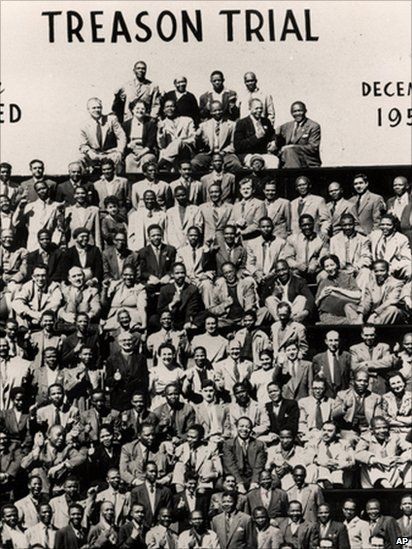 The Accused during the Treason Trial. Image source
The Accused during the Treason Trial. Image source
On 29 March 1961 Justice FL Rumpff interrupted the defense summation with a verdict. He announced that although the ANC was working to replace the government and had used illegal means of protest during the Defiance Campaign, the Crown had failed to show that the ANC was using violence to overthrow the government, and were therefore not-guilty of treason. The Crown had failed to establish any revolutionary intent behind the defendant's actions. Having been found non-guilty, the remaining 30 accused were discharged.
Women’s March
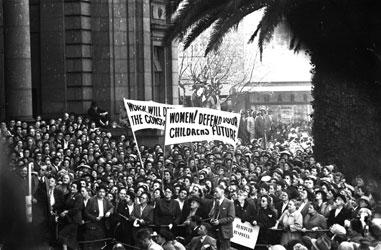 The crowd involved in the 1956 Women March, which led to the establishment of Womens day on 9 August. Image source
The crowd involved in the 1956 Women March, which led to the establishment of Womens day on 9 August. Image source
The women’s march was greatly a response to one of the Apartheid laws that were originally imposed on African men alone. Although African men had been required to carry passes for many decades, only in the 1950s did the government impose pass laws on African women. The first attempt to make black women in South Africa carry passes was in 1913 when the Orange Free State introduced a new requirement that women, in addition to existing regulations for black men, must carry reference documents. The resulting protest that was by a multi-racial group of women, many of whom were professionals (a large number of teachers, for example), took the form of passive resistance - a refusal to carry the new passes. African women were not allowed to live in towns unless they had permission to be employed there, and extending pass laws to them made it more difficult for women without jobs to take their children and join their husbands in town. Many of these women were supporters of the recently formed South African Native National Congress (which became the African National Congress in 1923, although women were not allowed to become full members until 1943). The protest against passes spread through the Orange Free State, to the extent that when World War I broke out, the authorities agreed to relax the rule. Across the country, dozens of protests against pass laws for African women took place before the Federation of South African Women (formed in 1955) and the African National Congress Women’s League organized a massive protest march in Pretoria.
At the end of World War I, the authorities in the Orange Free State tried to re-instate the requirement, and again opposition built up. The Bantu Women's League (which became the ANC Woman's League in 1948 - a few years after membership of the ANC was opened to women), organized by its first president, Charlotte Maxeke, coordinated further passive resistance during late 1918 and early 1919. By 1922 they had achieved success - the South African government agreed that women should not be obliged to carry passes. However, the government still managed to introduce legislation which curtailed the rights of women and the Native (Black) Urban Areas Act No 21 of 1923 extended the existing pass system such that the only black women allowed to live in urban areas were domestic workers.
With the Blacks (Abolition of Passes and Co-ordination of Documents) Act No 67 of 1952, the South African government amended the pass laws, requiring all black persons over the age of 16 in all provinces to carry a 'reference book' at all times - thereby enforcing influx control of blacks from the homelands. The new 'reference book', which would now have to be carried by women, required an employer's signature to be renewed each month, authorization to be within particular areas, and certification of tax payments.
During the 1950s women within the Congress Alliance came together to combat the inherent sexism that existed within various anti-Apartheid groups, such as the ANC. Lillian Ngoyi (a trade unionist and political activist), Helen Joseph, Albertina Sisulu, Sophia Williams-De Bruyn, and others formed the Federation of South African Women. The prime focus of the FSAW soon changed, and in 1956, with the cooperation of the ANC's Women's League, they organized a mass demonstration against the new pass laws.
On August 9, 1956, 20,000 women, representing all racial backgrounds, came from all over South Africa to march on the Union Buildings, where they stood in silent protest for 30 minutes while petitions with 100,000 signatures were delivered to Prime Minister JG Strijdom’s office. These petitions were in favour of the introduction of new Pass Laws and the Group Areas Act No. 41 of 1950. Many men in the anti-apartheid movement were surprised by the women’s militancy, and the protest contributed to women playing a bigger role in the struggle for freedom and democracy. August 9th now is celebrated as National Women’s Day in South Africa.
During the march the women sang a freedom song: Wathint' abafazi, Strijdom!
wathint' abafazi,
wathint' imbokodo,
uza kufa!
[When] you strike the women,
you strike a rock,
you will be crushed [you will die]!
Brief biographies: Helen Joseph and Lillian Ngoyi and their roles in resistance to apartheid
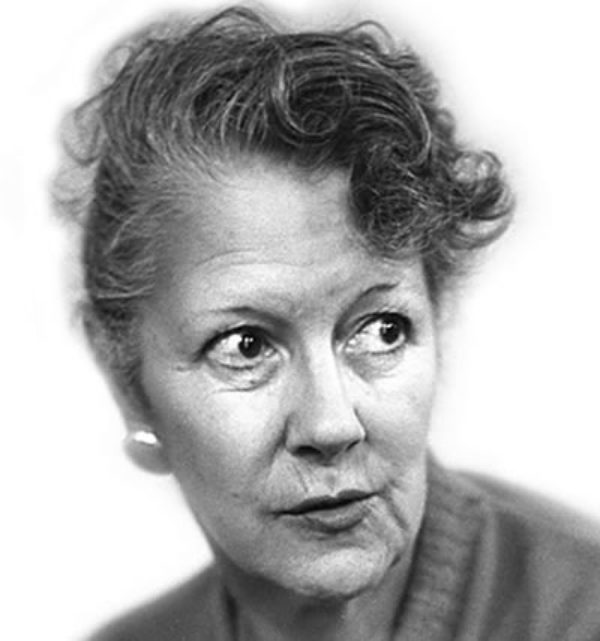 Helen Joseph Image source
Helen Joseph Image source
Helen Joseph: Helen May Fennell was born in Sussex, England, in 1905 and grew up with her parents and brother. She graduated from King’s College, University of London, in 1927 with a degree in English. She then went to India to teach at a school for girls in Hyderabad for three years. In 1931 Helen came to Durban, South Africa where she met her husband, Billie Joseph.
During the Second World War Helen served as an Information and Welfare officer for the Women's Auxiliary Air force where she decided to become a social worker. In 1951 she took a job with the Garment Worker’s Union, led by Solly Sachs. During this time, and as a result of working closely with Sachs, Helen came to see and experience the "true face" of Apartheid, which angered her tremendously due to its blatant injustice. Helen was a founding member of the Congress of Democrats (the ANC's white ally). In 1955 Helen was selected as one of the people who read out clauses of the Freedom Charter at the Congress of the People in Kliptown. In 1956, Helen led a march of 20 000 women to Pretoria's Union Buildings in protest of the Pass Laws.
Like some of South Africa’s black leaders during that time, Helen was arrested on a charge of high treason, followed by her being banned in 1957 as well as being the first person to be placed under house arrest. When she was 80, she regained her freedom when her final ban was lifted in 1985.
Helen died on 25 December 1992 in Johannesburg, Gauteng.
Lillian Ngoyi: Lillian Ngoyi was one of the women leading the Women’s March on 9 August 1956. She was born on 25 September 1911 and she, a widowed seamstress supporting two children and an elderly mother, joined the ANC Women’s League in 1952. She went on to become the first woman elected to the executive committee of the African National Congress.
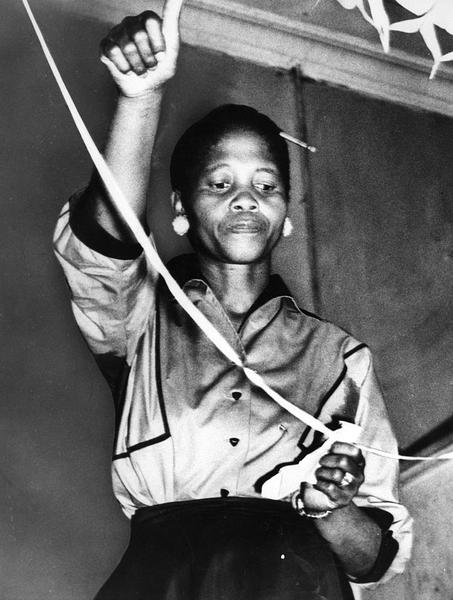 Lillian Ngoyi Image source
Lillian Ngoyi Image source
She travelled to Switzerland in 1955 to participate in the World Congress of Mothers held by the Women’s International Democratic Federation to plead the cause of black women in South Africa. Then she went on to visit England, Germany, Romania, China and Russia before returning to South Africa as a “wanted woman”. She was arrested in 1956, spent 71 days in solitary confinement and for eleven more years was banned and confined to her home in Orlando, Soweto, causing great suffering for her and her family. Mangosuthu Buthelezi and Beyers Naudé wrote several letters pleading Lilian Ngoyi’s cause. Naudé discussed her various domestic and financial needs, while raising the possibility of her banning order being lifted.
Amongst the many honours since the fall of apartheid that have been heaped on her, a community health centre in Soweto, a Hall at Rhodes University, as well as an environmental patrol vessel is named in her honour.
Lilian Masediba Ngoyi died on 13 March 1980, many years before the country would reap the fruits of her labour despite her express wish: “I am hoping with confidence that, before I die, I will see change in this country.”
